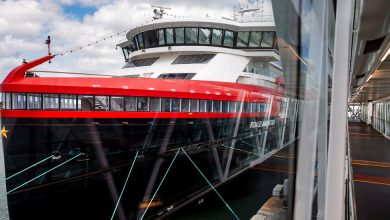275 Minutes on Hold: Why Airline Customer Service Still Can’t Keep Up

After Southwest Airlines canceled his family’s flight on Oct. 9, Tyler Reece Maness realized that his best option was to drive 18 hours from Oklahoma City to Orlando, Fla. That’s the only way his 7-year-old daughter would make it to it Boo Bash, Disney World’s $159-a-person Halloween event, the following night.
Mr. Maness’s flight was one of around 2,000 the airline canceled that weekend. What made him angry, he said, was not the cancellation per se. It was that he only learned about it from another passenger after an agent checked their bags, and that his wife had wasted a total of 90 minutes on two calls trying to rebook their flights. (Both calls were dropped.) His wife, Carissa, said she was also infuriated by losing hours trying to reach someone on the phone to explain why, a month later, they have yet to get their $1,600 refund.
“A massive airline like Southwest is making money hand over fist,” said Ms. Maness. Indeed, Southwest reported a $446 million profit in the third quarter, thanks in part to $763 million in government support. “They should have more customer service representatives on standby to handle the influx of calls,” she said.
Similarly, Paulina Morales, whose flight was among the more than 2,000 flights that American Airlines canceled between Oct. 30 and Nov. 1, was less annoyed about the cancellation than about the length of time she spent on the phone trying to rebook a flight from Chihuahua, Mexico, to the Los Angeles area: 4 hours and 54 minutes.
“I’ve never had to be on hold that long for any customer service in my life,” she said.
Over the past few months, customers around the world have been lamenting call wait times and, more broadly, the process of rebooking canceled flights. Virtually every airline’s social media account is overflowing with stories of hourslong waits to speak to someone — even on relatively normal days.
“It’s a joke all over,” said Gilles Alexandre Bussutil, a consultant who specializes in helping airlines improve customer experience.
The issues have to do with staffing, according to many airlines, reservation agents and industry analysts, but exactly who or what is to blame depends on whom you ask. Some airlines, including Southwest, have acknowledged that they’ve recently let customers down and need to hire more agents. But other airlines have suggested the exorbitant wait times of early summer are ancient history, something that does not seem to be reflected by customers’ stories.
“Average wait times have been reduced since June and continue to shorten every week,” said Ed Bastian, Delta’s chief executive, in an email to customers in September, which credited recent hiring for fixing the problem. Robin Hayes, the chief executive of JetBlue, similarly stated, “I’m pleased with the progress we’ve made since the summer,” at a conference last month, citing the hiring of hundreds of new agents for bringing down wait times.
“Oh sure, it’s been taken care of; it’s under control,” said Omar Martinez, a longtime JetBlue loyalist, who was feeling tempted to give up on the airline. In August, Mr. Martinez spent 275 minutes on a call for a matter that a gate agent told him could only be resolved over the phone. But in talking to friends and looking to social media, he has yet to find an airline without similar issues.
What it’s like answering calls when your employer cancels 2,000 flights
Passengers who were unable to get anyone on the phone to rebook Southwest flights in October questioned why the airline didn’t put more agents on the schedule. Stephanie Belle, one of around 2,600 customer support representatives for Southwest, offered a partial answer: The company had already tapped into its deepest reserves.
Ms. Belle has been with Southwest in Houston for 19 years and has the seniority to typically avoid mandatory overtime. But on that disastrous Tuesday and Wednesday, she was called in two hours early to her minimalist home office with a view of her bougainvillea plants. Beyond the extra hours, Ms. Belle said, her week was not much different than usual: She tried to solve lots of problems.
“If they are frustrated, I calm them down,” she said of the callers.
Before the pandemic, many airlines employed more reservations agents. But as government travel restrictions and fears of the coronavirus pummeled the airline industry, most companies let people go. Nearly 400 customer representatives at Southwest took voluntary separation packages; a quarter of the American Airlines reservations team elected to leave; and the Dubai-based airline, Emirates, reduced its work force by 31 percent, according to representatives at these companies. In August, The Wall Street Journal reported that Delta’s call center staffing was down 50 percent.
Then, come summer, travel began to rebound — and it was all the more confusing because of shifting government restrictions and testing requirements and a desire to apply credit from flights that the pandemic had canceled. So now airlines were managing more calls with fewer employees — and even the levels they’d started out with early on in the pandemic probably weren’t sufficient, said Mr. Bussutil, the customer experience consultant.
Over the past 10 years, airlines have replaced thousands of people with online tools. Sometimes the tools are more than adequate; by now, most passengers are content booking online. But not everything can be done online. Most airlines don’t allow customers to rebook themselves to an alternative arrival destination, for example.
To keep up with call volume, employees were regularly required to pick up overtime, employees of unions that represent reservation agents for Southwest Airlines and American Airlines said. But as the pandemic wore on, airlines’ tactics to keep wait times down despite understaffing were beginning to take a toll on employees.
“When you cannot plan things on your day off, it can break your morale,” said Edison Fraser, the transportation coordinator for the International Association of Machinists and Aerospace Workers, a union that represents reservation agents for Southwest Airlines.
Emirates, which employs 1,900 people to handle calls, says that the median wait time to get an agent on the phone is just over six minutes. The company, which is one of the world’s largest airlines, pulls this off by giving agents goals involving a specific number of seconds for handling various types of calls, emails shared with The New York Times show.
Keeping a call to around 500 seconds, or 8.5 minutes, became far more stressful during the pandemic, said a former Emirates reservation agent, who asked not to be identified by name because her contract prohibits her from talking about her employer. Passengers expected her to answer questions like: Would there be someone from a particular country with a high infection rate seated within five rows of me? When she couldn’t answer, they often yelled.
She rarely made her metrics goals, which were tied to bonuses, and so she quit.
“We’re not machines,” she said. (An Emirates representative said that these time goals are “benchmark values” used “primarily for forecasting purposes, in order to ensure that we are sufficiently resourced to handle the requests from our customers.”)
So why not hire more people?
That’s the plan, according to numerous airlines. But passengers are not likely to see this plan translate into lower wait times any time soon, several industry analysts said. They offered several theories as to why not.
Theory one is that hiring quickly is impossible because airlines, like restaurants and retailers, are grappling with a labor shortage. In support of this theory, Dan Landson, a spokesman for Southwest, said that the company has never had a harder time filling jobs. The company is trying to hire 1,000 customer representatives, he said, but instead of 80 applicants per opening, a prepandemic standard, the company is getting between 10 and 15 applicants.
American, which recently hired thousands of reservation agents, bringing its total to 4,400 in the United States, with plans to hire more still, said that it’s also struggling to fill jobs.
Mr. Bussutil, the customer experience consultant, believes that younger generations are no longer excited about working for airlines. “Maybe 30 years ago, there was some level of prestige,” he said. Now, “it’s just a job.” This makes it difficult for airlines to find talent — and the word “talent” is not an exaggeration, he said, given that they value people who speak multiple languages, learn complex systems quickly and will stay cheerful with frustrated customers.
Theory two is that hiring enough qualified employees is hard because airlines don’t pay enough. Reservation agents start at $13.05 an hour with American (with an eventual high of $34.12) and $15 an hour for Southwest, for example. Delta, which said that it’s not having the same trouble filling positions, declined to state how much the company pays.
When you can find jobs at McDonalds and Starbucks that pay more than the airlines, “the number of potential employees for hire becomes limited,” said Mr. Fraser of the International Association of Machinists and Aerospace Workers.
Theory three is that focusing entirely on hiring is a mistake because it’s not only about staff numbers, it’s about how staff is deployed. Several United employees at Newark Liberty International Airport recently showed off the company’s new solution to long wait times: Agent on Demand, or “the outrageous A.O.D.,” as Sulaima Hernandez, a customer service supervisor, called it. “It’s outrageous because it’s so awesome,” she said.
Instead of calling or waiting for a gate agent, customers scan a QR code, which gives them the option to text, talk or video chat about their issue. In some airports, passengers can connect to A.O.D. through a kiosk. The idea is that every ticket agent will eventually be trained on A.O.D. so that he or she can hop in to fill the void when weather, for example, causes mass cancellations elsewhere. The tool supplements the existing 5,000-person reservation agent team.
After spending her morning at a ticket counter, Michelle Rosario, a lead customer service representative for United, retreated to a computer in a room near a gate and rapidly worked her way through a queue of seat changes and baggage issues.
A masked woman who had just landed in San Francisco and was dealing with a tight connection popped up on the screen. She had elected to video chat. Her face then froze. This was likely because of poor reception on her end, but it didn’t make a strong case for video chat.
Dean Headley, the co-author of Airline Quality Rating from Wichita State University in Wichita, Kan., who had not tried the new system, said it’s symbolic of a longstanding trend throughout the airline industry.
“They are trying to work with technology instead of staffing up with people that can answer the damn phone,” he said.
He also offered a fourth theory why airlines are unlikely to fix call wait times any time soon: “They believe there is always another person who will buy that ticket and that’s probably not altogether incorrect,” he said.
Follow New York Times Travel on Instagram, Twitter and Facebook. And sign up for our weekly Travel Dispatch newsletter to receive expert tips on traveling smarter and inspiration for your next vacation. Dreaming up a future getaway or just armchair traveling? Check out our 52 Places list for 2021.





